What's inside
The leg press is an absolute staple exercise in many leg day workouts.
The leg press machine is a safer alternative to free-weight exercises like the barbell squat.
That being said, the leg press still requires some know-how for those new to using it.
If you’ve seen your fellow gym-goers using a leg press machine, you may have noticed that different people use different techniques.
One of the most noticeable differences between lifters on the machine is in their foot placement for leg press exercises.
That’s what this article is all about.
In this ultimate guide to leg press foot placement, we’ll discuss why foot placement is important and how it affects your training.
We’ll cover different leg press stances, machines, foot placements, and how to do each for a different spin on your leg session.
There are also some great tips for using the leg press machine to get the most out of it, no matter your goals in the gym.
Where do you place your feet on a leg press?
Related: How To Get Rid Of Chicken Legs

The best place to position your feet on a leg press machine plate depends on your build, health status, and training goals.
Different foot positions emphasize different areas of your leg muscles, as well as on the ankle, knee, and hip joints.
In this article, we’ll outline the major muscles the leg press targets and how different foot positions can work certain muscles more.
You’ll also learn which foot placement is best for different injuries or areas of lower limb pain.
What does leg press foot placement mean?
Related: Why Are My Legs So Skinny
Leg press machines involve sitting or lying in a supported position and placing your feet on a foot plate.
This is usually in the form of a large, rectangular metal plate with an embossed surface for added grip.
These plates are quite large, allowing you to place your feet in a range of different positions across them.
The positioning of your feet on the plate can make a big difference in the effects the exercise has on your muscles and joints.
Different foot placement can make the same weights seem easier, heavier, or even painful in cases where it is not optimal for an individual.
Let’s break down the muscle groups we are trying to target when working on a leg press machine.
Which muscles are worked in the leg press?
Related: 5 Day Dumbbell Workout Split For Muscle Building
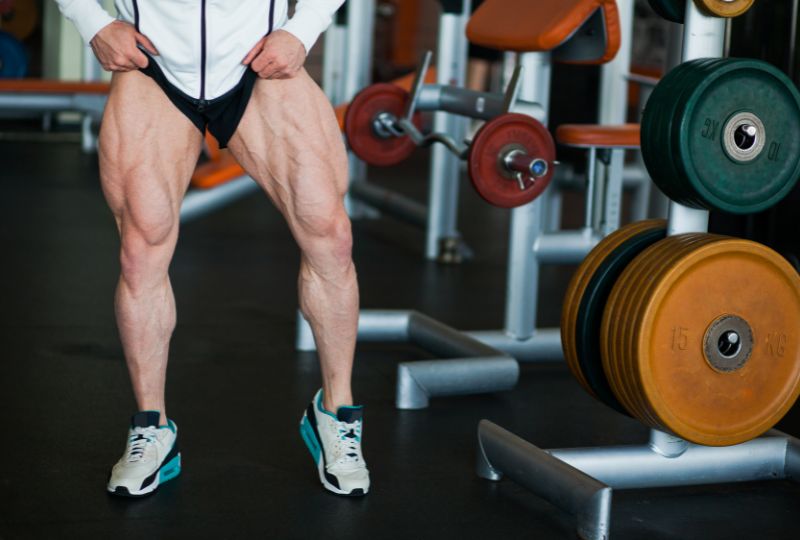
The leg press is a compound, multi-joint lower body exercise.
It recruits many major muscle groups in the thighs, lower legs, and trunk.
The movements performed in the leg press are flexion and extension in the ankle, knee, and hip joints.
The leg press is considered a closed chain exercise as the feet are planted on the plate while moving the weight.
The major muscles involved in the leg press include:
- Quadriceps: Rectus femoris, vastus lateralis, vastus medialis, vastus intermedius
- Hamstrings: Biceps femoris, semitendinosus, semimembranosus
- Glutes: Gluteus maximus, medius, minimus
- Adductors: Magnus, brevis, longus
- Calves: Gastrocnemius, soleus
- Core: Transverse abdominis, pelvic floor, diaphragm, quadratus lumborum
Many other muscles in the upper and lower leg, as well as the trunk, feet, and upper body are used to stabilize and support the body in the leg press.
For the purposes of foot placement, we will mainly be focused on the quads, hamstrings, glutes, and to a lesser extent, the calves.
The superficial three heads of the quads are worth noting here – the inner ‘tear drop’ head (vastus medialis), outer head (lateralis), and the central rectus femoris.
These muscles that collectively form the quadriceps have different activation levels as we change foot positions on the leg press plate.
There are also specific placements to focus more on the hamstrings and glutes.
Next, let’s distinguish between the different makes of leg press machines as these can also affect foot placement.
Leg Press Machine Types
Plate Loaded Machine

One of the commonly seen leg press machines in commercial gyms is the 45-degree leg press machine.
These heavy-duty machines are loaded up with weight plates on either side.
This machine is named after the angle of the rail which guides the foot plate.
On this machine, you sit in an inclined seat in a low position and press the plate up at a 45-degree angle.
The seat can be adjusted at different angles. Research also shows differences in muscle activation when this is changed.
Pin-Loaded Machine – Horizontal

The lying or horizontal leg press can also be found in many gyms and is more popular in hotel and boutique gyms.
These machines are pin-loaded, meaning the weight is set and controlled by a pulley system.
In this variation of the machine, instead of sitting, the user lays back and has shoulder pads to push against.
These machines are unique in that the backrest, rather than the foot plate, is what moves back and forth.
Because you are lying back more, these machines also allow for a greater range of hip extension.
One drawback of the lying leg press is that it sometimes doesn’t suit tall people, as the tracks can be limited in length.
Pin-Loaded Machine – Seated
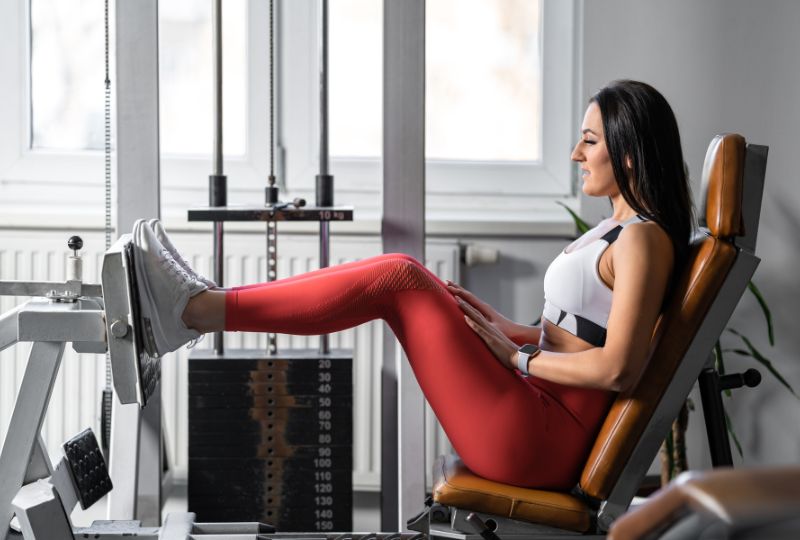
This is similar to the pin-loaded machine above. However, this one is in an upright seated position.
It’s probably more similar in feel to the 45-degree leg press, although it can feel more comfortable for some users.
Whatever type of leg press you have access to, it’s important that we go over the correct technique of the exercises.
After we cover the basics, we’ll explain in further detail the steps for different foot placements, including seated leg press foot placement.
How to Use the Leg Press Machine
alt/image: leg press machine
The following are the general steps to go through when performing a leg press.
The video example above demonstrates a 45-degree leg press machine, which has an additional safety mechanism.
Here is how to perform the leg press exercise:
- Sit in the seat of the machine with your back on the backrest.
- Place your feet flat on the plate.
- On a 45-degree machine, push the platform away slightly and turn the safety handles away.
- Hold the handles provided.
- Start from a straight (but not locked out) leg position.
- Inhale and slowly lower the plate toward you until the hips and knees are at about 90 degrees.
- Exhale and drive through the heels to push the legs back to the starting position.
- Be sure to turn back the safety handles to set the plate before taking the feet off.
In a seated leg press machine, you’ll often begin from the bottom position, so just reverse the steps of straightening and bending the legs.
Now, let’s dive into the details of where to place your feet on the leg press machine.
The Three Directions of Leg Press
Height
The first variable in leg press foot placement is the vertical positioning.
You can place your feet at the top of the plate, closer to the bottom, or anywhere in between.
This has a big impact on the angles and forces during ankle, knee, and hip flexion and extension.
It can also affect your lower back if you lack sufficient flexibility in the leg muscles.
Width
The next way you can alter foot placement is the width of your stance.
This element shares common ground with the classic barbell squat as stance width is something that can also be modified in that exercise.
The feet can be placed in a narrow, shoulder-width, or wide stance on the plate.
This changes the angle of the knee relative to the hips in the frontal plane of movement.
Width also affects the degree of knee flexion you can achieve in the leg press.
Angle
Finally, we have the foot angle which can be changed during leg press foot placement.
The toes can be aligned straight up on the plate or rotated out to varying degrees.
This changes rotation in the hips and causes muscles to work slightly differently throughout the movement.
Foot angle often goes hand-in-hand with stance width, with some people using a turned-out angle with narrow or wide stance leg press exercises.
While some research suggests minimal effect of forefoot angle on muscle activation in the leg press, it is definitely relevant to comfort and technique for different individuals.
With these three elements in mind, let’s go through several of the most common foot placement styles you can try with your leg press.
Leg Press Variations: The Most Common Foot Placements
The following are some of the common types of leg press foot placement you’ll see in the gym.
For each, we describe how to place the feet before you follow the general leg press technique steps outlined above.
Also, check out the pros and cons as we suggest who each foot placement variation might be the most suitable for.
Regular Leg Press Foot Placement
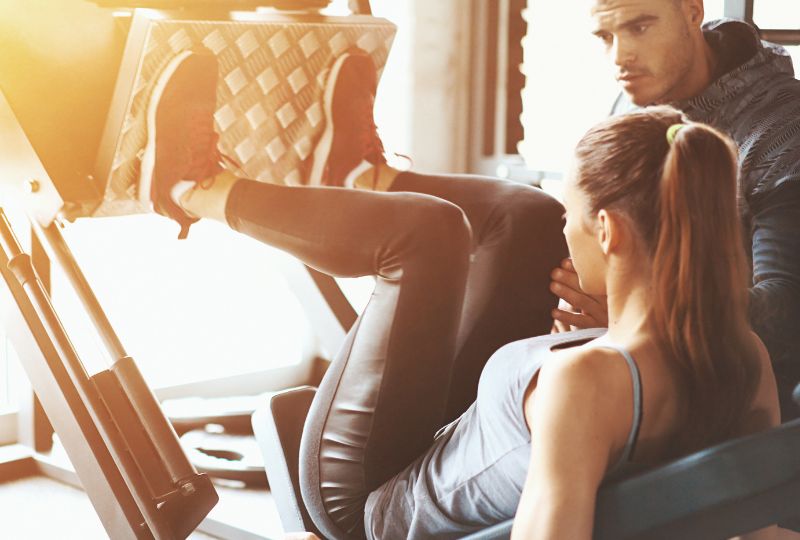
alt/image: regular leg press foot placement
- Mechanism: Place the feet hip to shoulder-width apart, in the center of the plate.
- Muscles emphasized: General quads, glutes, hamstrings, calves.
- Pros & cons: Good starting point, hits everything, but better moves to target certain heads.
Wide Stance Leg Press Foot Placement
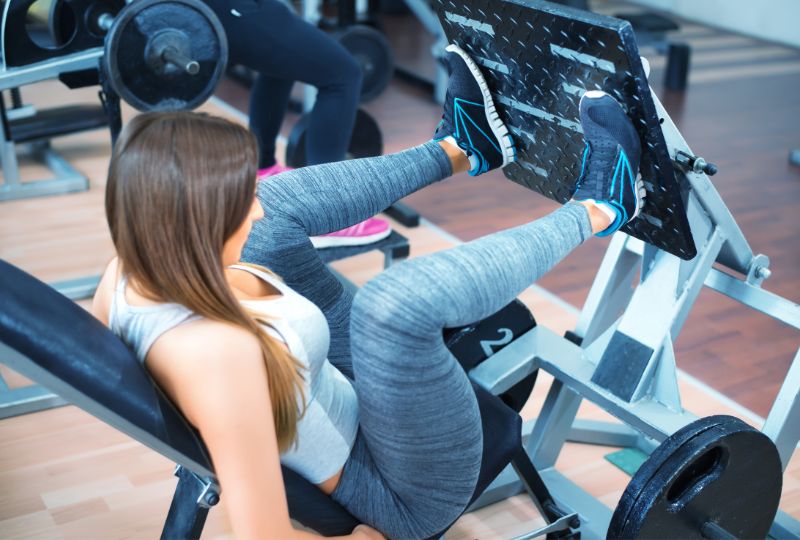
- Mechanism: Place the feet 1.5x shoulder-width or wider with toes very slightly turned out.
- Muscles emphasized: Adductors, glutes, hamstrings.
- Pros & cons: Good stretch for inner thigh muscles, but requires good posterior flexibility.
Narrow Stance Leg Press Foot Placement

- Mechanism: Place the feet slightly narrower than hip-width apart; toes turned out 45 degrees optional.
- Muscles emphasized: Vastus lateralis (outer head of quads), calves.
- Pros & cons: Great quad-dominant variation, heavy on the knee extension angle and requires high ankle mobility.
High Leg Press Foot Placement
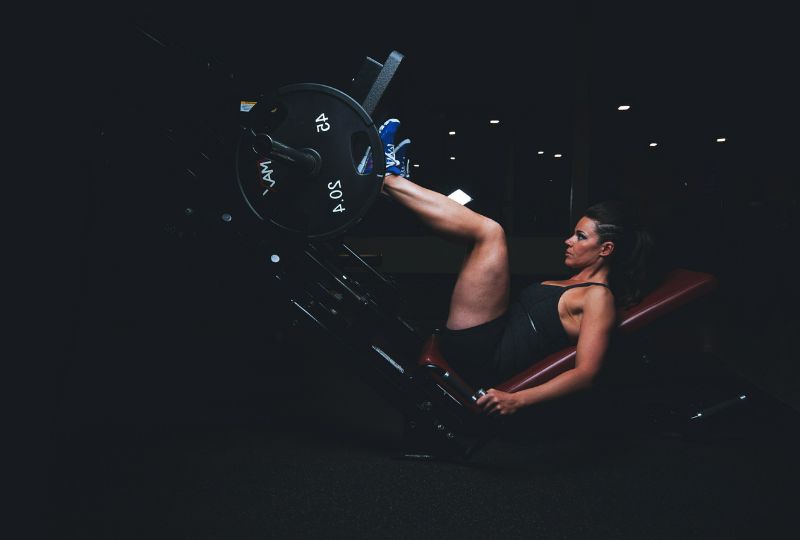
- Mechanism: Place the feet hip to shoulder-width apart, higher towards the top of the plate.
- Muscles emphasized: Glutes, hamstrings.
- Pros & cons: Easier on the knees, excellent glute engagement, but lesser quad activation.
Low Leg Press Foot Placement
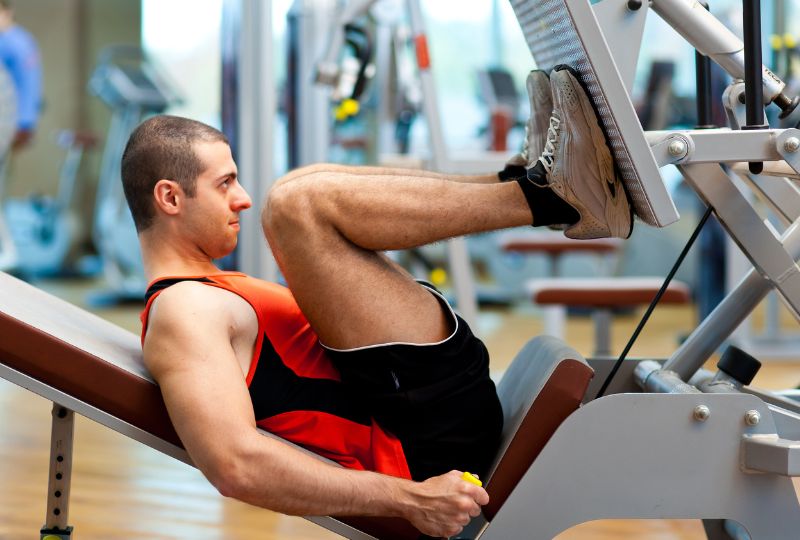
- Mechanism: Place the feet hip to shoulder-width apart, low toward the bottom of the plate. Keep the entire foot on the plate and ensure the heels contact the plate at all times.
- Muscles emphasized: Quadriceps (especially VMO if toes turned out), calves.
- Pros & cons: Intense quad exercise with increased knee flexion angle; however, it might aggravate those with sore knees.
Check out this video for a good summary of the standard, high, and wide foot stance variations:
And here’s another no-nonsense video on the narrow, standard, and wide (with toes turned out) foot placements:
Other Leg Press Foot Placements
- Single leg press: Place one foot on the plate in line with the same-side knee and hip.
- Externally rotated feet: Mentioned above, this can be done based on personal preference or slightly emphasizing the VMO portion of the quads.
- Leg press calf raises: This exercise can be done on the leg press machine and involves placing the balls of the feet on the bottom of the plate with the heels off.
Leg Press Benefits and Pro Tips
Leg Press Benefits
- It’s safer on the spine as the back is supported.
- You can lift heavier weights than free weight leg exercises.
- It’s an entire compound leg builder.
- The machines are widely available – most gyms have more than one.
- Wide variation of stances allows entire leg workout on one machine.
- It’s easy to adjust and progress weight.
- It has a lower skill ceiling than barbell squats.
- The machines have built-in safety mechanisms to avoid dropping weight.
Leg Press Pro Tips
- Try barefoot leg press for better foot and lower leg engagement.
- Alternatively, squatting shoes help ankle mobility in the leg press.
- Don’t limit yourself to one stance – alternate foot placement throughout your program.
- You can have multiple leg press variations in one workout or program.
- You can use a spotter to go beyond failure with the leg press (advanced).
- Most importantly – avoid the mistakes below to prevent injury!
Leg Press Common Mistakes
Related: Should You Do Cardio On Leg Day?
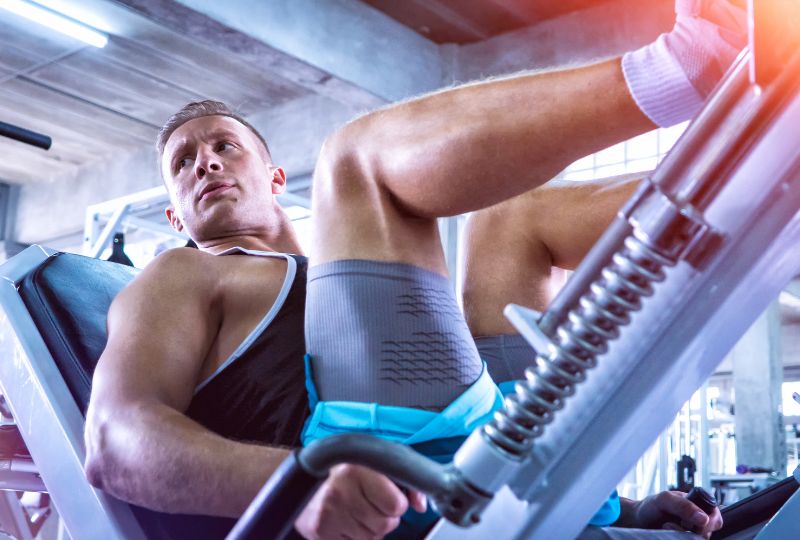
Lifting Heels
Leg press foot placement should be done in a way that allows you to keep the pressure in the heels throughout.
Lack of ankle mobility or lifting too much weight can result in the heels lifting off the plate.
This can lead to strain in the tendons and ligaments around the front of the knee, especially with heavy weights.
Pay particular attention to this with the low foot placement, as this is when the heels will want to lift if you don’t have the ankle mobility.
Rounding Lower Back
A very common mistake with the leg press is lowering the weight too far down so the hips and lower back round and lift from the back support.
This can be very dangerous to your lower back, especially with heavy weights on the machine.
Engage your core, glutes, and lower back to keep the back firmly pressed into the seat.
Also, only lower the plate down to a level where you can safely press it back to the starting position.
Keep an eye out for this mistake, particularly with the high foot placement variation.
Locking Out Knees
Finally, we have another commonly-seen mistake that beginners fall prey to on the leg press.
When the muscles get fatigued, we want to relieve the tension by locking out the knees – like we do when standing.
However, in the leg press, all the force of those heavy weights is pressing directly toward the knee joint.
It’s critical to keep the tension in the muscles – which is the point of the exercise anyway.
Avoid locking out the knees, only straightening the legs as far as possible without lock-out.
Alternatives to Leg Press
Related: Leg Press Alternative
If for some reason you are unable to add a leg press into your routine, there are many other options.
Other compound leg exercises that achieve a similar effect include the classic squat, with any of its many variations used to add resistance.
Alternatively, there are other compound leg machines, such as the hack squat, Smith machine squat, or V-squat machine.
Of course, there are also dozens of exercises that target the leg muscles in different combinations or in isolation.
Lunges, deadlifts, leg extensions, hamstring curls, or calf raises are just a few of the many options.
Frequently Asked Questions
How to do leg press?
See our step-by-step above for the correct technique to perform a leg press, in combination with the instructions for your preferred foot placement.
In brief, set up in the seat, place the feet on the plate, unlock the safety rack, inhale to lower the weight, and exhale to straighten the legs to the starting position.
Does foot placement matter on leg press?
While not the only important variable, foot placement does definitely affect the way the exercise hits your muscles.
Other elements include movement velocity, or time under tension, load or intensity, and overall volume.
Where do you place your feet on a leg press?
There are many positions you can have your feet in the leg press exercise.
The variations above all show that the best foot placement for you will depend on your training level, injury status, and the muscles you want to target.
Where should I put my feet in the leg press for quads?
All leg press variations will work the quadriceps to some extent.
That being said, lower foot placements create more knee flexion, which recruits the quads more to extend the knee.
Try a narrower, lower foot placement for an intense quad exercise – following the steps above, of course.
How high up should feet be on a leg press?
Placing your feet in the center of the plate is the best place to start for those new to the leg press.
As you become more experienced, you can experiment with higher foot placements that will further emphasize the glutes and hamstrings.
Higher foot placement will take some of the stress from your knees but will require more concentration to keep your back from rounding.
Final Thoughts
So, what did you think of our ultimate guide to leg press foot placement?
Let us know if you have the leg press in your program – and which stance you use – in the comments.
If you know anyone struggling with leg press technique, be sure to share this article to help them out.

